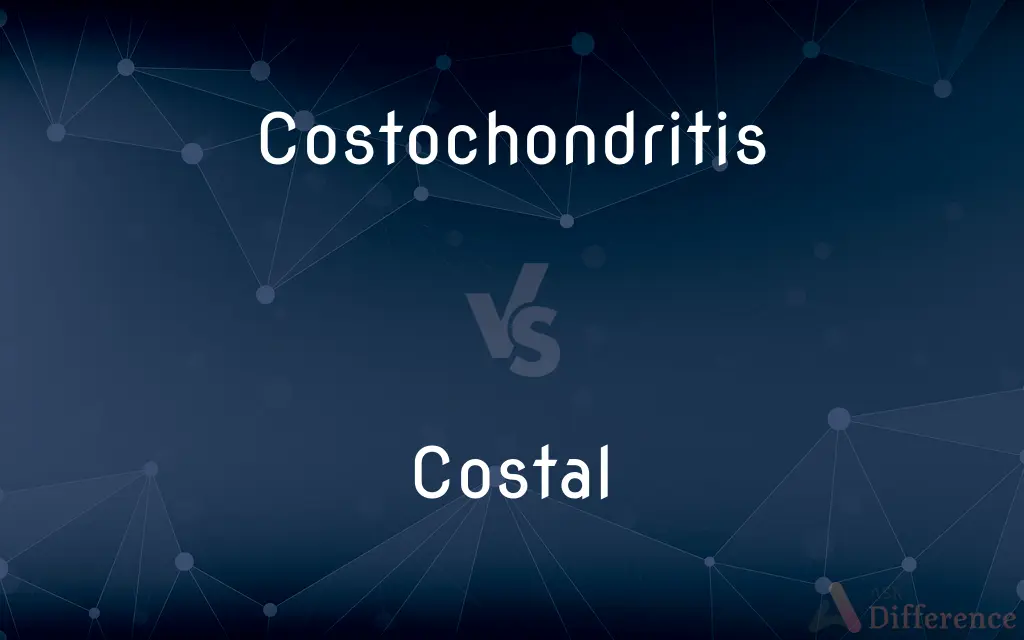Costochondritis vs. Costal — What's the Difference?
By Maham Liaqat & Urooj Arif — Updated on April 9, 2024
Costochondritis is an inflammation of the cartilage in the rib cage, often causing chest pain, whereas "costal" refers to anything related to the ribs.

Difference Between Costochondritis and Costal
Table of Contents
ADVERTISEMENT
Key Differences
Costochondritis is a medical condition characterized by the inflammation of the cartilage that connects a rib to the sternum (breastbone), which can cause significant chest pain resembling that of a heart attack. This pain is often sharp and can be exacerbated by certain movements or deep breathing. On the other hand, the term "costal" is an adjective used to describe anything pertaining to the ribs. It can be used in various contexts, from anatomy (costal cartilage) to conditions affecting the rib area (costal pain), but it does not specify a particular disease or condition.
The causes of costochondritis are often idiopathic, meaning they are unknown, but can include physical strain, injury to the chest area, or respiratory infections that lead to repetitive coughing. In contrast, "costal" as a descriptor does not inherently include causes or conditions but rather qualifies objects or concepts related to the ribs. For instance, costal breathing refers to the movement of the chest wall during breathing, emphasizing the expansion and contraction of the rib cage.
Diagnosis of costochondritis typically involves a physical examination, with doctors pressing on the costosternal, costochondral, and costovertebral angles to identify pain points. Imaging tests might be employed to rule out other conditions. Conversely, references to "costal" aspects, such as costal margins or costal surfaces, would be part of a descriptive process in medical examinations or anatomical discussions, rather than a diagnosis.
Treatment for costochondritis often focuses on pain relief, including the use of nonsteroidal anti-inflammatory drugs (NSAIDs), physical therapy, and in some cases, corticosteroid injections. There is no specific treatment associated with the term "costal" itself, as it would depend on the particular condition or context being referred to. For example, costal cartilage damage might require different management compared to costochondritis.
While costochondritis has a specific set of symptoms, mainly centered around chest pain that can mimic other serious conditions like a heart attack or gastrointestinal issues, "costal" is not associated with specific symptoms. Instead, it is used to describe anatomical parts or related conditions, implying a broader and more general application in medical and anatomical terminology.
ADVERTISEMENT
Comparison Chart
Definition
Inflammation of the cartilage connecting ribs to the sternum
Pertaining to the ribs
Causes
Often idiopathic, physical strain, injury, infections
Not applicable (descriptive term)
Diagnosis
Physical examination, imaging tests to rule out other conditions
Used in descriptive/anatomical context
Treatment
NSAIDs, physical therapy, corticosteroid injections
Depends on the specific costal condition
Symptoms/Usage
Chest pain, especially with movement or breathing
Describes location, structures related to ribs
Compare with Definitions
Costochondritis
Inflammation of Cartilage.
Costochondritis often results in sharp chest pain that worsens with deep breaths.
Costal
Varies by Condition.
Costal pain can indicate different issues, from fractures to muscle strain.
Costochondritis
Diagnosed by Physical Exam.
Doctors diagnose costochondritis by applying pressure to the chest to find painful areas.
Costal
Related to the Ribs.
The costal cartilage connects the ribs to the sternum.
Costochondritis
Treated with NSAIDs.
Nonsteroidal anti-inflammatory drugs are commonly prescribed for costochondritis pain relief.
Costal
Non-specific Application.
Costal margin refers to the lower edge of the chest formed by the bottom ribs.
Costochondritis
Idiopathic or Due to Strain.
Costochondritis can arise without a known cause or from physical activities that strain the chest.
Costal
Descriptive Term.
Costal breathing involves the movement of the chest's rib cage.
Costochondritis
Common in Chest Area.
The pain associated with costochondritis is primarily located in the chest, near the sternum.
Costal
Anatomical Context.
The costal surface of the lung faces the rib cage.
Costochondritis
Costochondritis, also known as chest wall pain syndrome or costosternal syndrome, is a benign inflammation of the upper costochondral (rib to cartilage) and sternocostal (cartilage to sternum) joints. 90% of patients are affected in multiple ribs on a single side, typically at the 2nd to 5th ribs.
Costal
A rib or a riblike part, such as the midrib of a leaf or a thickened anterior vein or margin of an insect's wing.
Costochondritis
(medicine) A benign inflammation of the costal cartilage, causing pain between the ribs.
Costal
Pertaining to a rib.
Costochondritis
Inflammation at the junction of a rib and its cartilage
Costal
(biology) Pertaining to a costa.
Costal
(entomology) Pertaining to the costa or to the wing areas next to it.
Costal
(historical) saco, {{ngd}}
Costal
Pertaining to the ribs or the sides of the body; as, costal nerves.
Costal
Relating to a costa, or rib.
Costal
Of or relating to or near a rib
Common Curiosities
What does "costal" mean?
"Costal" refers to anything related to the ribs, whether it be structures, pain, or movement.
Can costochondritis be serious?
While painful, costochondritis is not usually serious but can mimic more serious conditions like a heart attack.
How can I prevent costochondritis?
While not always preventable, avoiding injury to the chest and reducing strain on the ribcage can help.
What is costochondritis?
Costochondritis is the inflammation of the cartilage that connects the ribs to the sternum, causing chest pain.
How long does costochondritis last?
The duration can vary, from weeks to months, and is dependent on treatment and individual factors.
What part of the body is affected by costal conditions?
Costal conditions affect the ribs and related structures, like cartilage and surrounding muscles.
How is costochondritis diagnosed?
It's diagnosed through physical examination and possibly imaging tests to exclude other conditions.
Are costochondritis and costal conditions related?
Costochondritis is a specific condition affecting the costal (rib-related) cartilage, so it falls under the broader category of costal conditions.
What's an example of a costal condition?
Besides costochondritis, costal conditions can include rib fractures or costal cartilage injuries.
Is there a cure for costochondritis?
Treatment focuses on relieving pain; most cases improve over time without a specific cure.
What treatments are available for costal conditions?
Treatments vary depending on the condition, from pain management for costochondritis to surgical intervention for severe fractures.
Are children at risk for costochondritis?
Yes, children can develop costochondritis, though it's more common in adults.
Is costal pain always related to costochondritis?
Not necessarily; costal pain can arise from various issues, not just costochondritis.
Does costochondritis show up on X-rays?
Costochondritis itself does not show on X-rays, but imaging can rule out other causes of chest pain.
Can costochondritis affect breathing?
Yes, the pain from costochondritis can make deep breathing uncomfortable or painful.
Share Your Discovery

Previous Comparison
Flubber vs. Blubber
Next Comparison
Chicken vs. VultureAuthor Spotlight
Written by
Maham LiaqatCo-written by
Urooj ArifUrooj is a skilled content writer at Ask Difference, known for her exceptional ability to simplify complex topics into engaging and informative content. With a passion for research and a flair for clear, concise writing, she consistently delivers articles that resonate with our diverse audience.














































